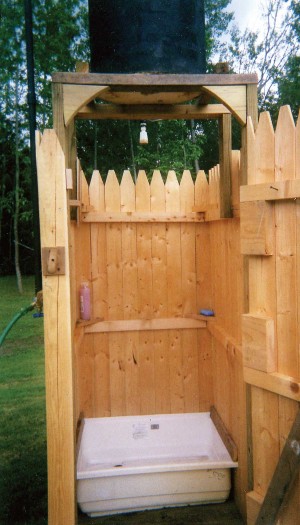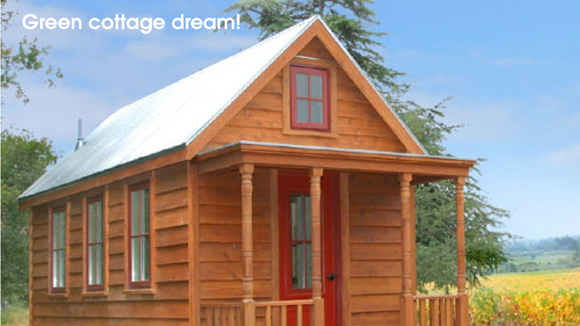Building a new home or cottage uses a lot of resources. By planning for a green cottage from the get-go, you will lighten your costs and your impact on the planet. There is an endless list of green building aspects I would like to cover, but I will try to stick to three main areas: build small, build local, and consider your future energy, water and waste inputs and outputs.
Small is beautiful
 Small really is beautiful! Some of the most beautiful spaces I’ve seen are small, well designed, open concept, and multi-purpose spaces. What do I mean by small? Some great plans I’ve come across lately in Tiny House Designs and Compact Cabins have designs ranging from 150 sq. ft. to under 1,000 sq.ft. Space (and resource) saving tips include designing storage to fit under your bed, using sofa beds for guests, and having a dining table that can flip up and tuck away into a wall or cupboard. By reducing the size of your cottage, you’ll reduce your site footprint and the impacts on your surroundings, reduce requirements for building materials, and reduce your cottage’s future energy demands. If your home is small enough, you may even be able to forgo a furnace and heat your home with solar hot water, an efficient wood stove, or small baseboard heaters. This link lists many of the beautiful books that are available on compact design.
Small really is beautiful! Some of the most beautiful spaces I’ve seen are small, well designed, open concept, and multi-purpose spaces. What do I mean by small? Some great plans I’ve come across lately in Tiny House Designs and Compact Cabins have designs ranging from 150 sq. ft. to under 1,000 sq.ft. Space (and resource) saving tips include designing storage to fit under your bed, using sofa beds for guests, and having a dining table that can flip up and tuck away into a wall or cupboard. By reducing the size of your cottage, you’ll reduce your site footprint and the impacts on your surroundings, reduce requirements for building materials, and reduce your cottage’s future energy demands. If your home is small enough, you may even be able to forgo a furnace and heat your home with solar hot water, an efficient wood stove, or small baseboard heaters. This link lists many of the beautiful books that are available on compact design.
Work with the site
By using the unique features and characteristics of your site, you can reduce site damage from construction, and gain a whole lot of energy savings!
Orient your cottage to make the most of passive solar energy. Plan your roof structure to provide you with proper shading in summer. And why not build your cottage so that it’s suited for our Manitoba climate! By designing a (very) well insulated cottage, you can stay cool in summer and warm in fall, winter and spring.
Think about building materials you can source close to your site. Straw bales can make wonderful building blocks for an owner-built cottage. Maybe there is a quarry nearby. Don’t forget to check your local building material re-use store. Check back often, as new items are always coming in. To make building process easier I would check used electric forklifts for sale and rent one. Another interesting option that may be available to you are pre-fab kits. By pre-fabricating the cabin off-site, construction waste can be greatly reduced.
One more consideration for your site of choice. How will you get there? Do you need to drive and then take a boat, or can you take a bus or train sometimes, and forgo the gas-powered boat completely?
Energy, Water and waste, oh my!
 Energy – Forgo the unnecessary appliances. Do you really need a washing machine and dishwasher at your cottage? For those appliances you do need, get the smallest, most efficient items you can find. Again, do you need an oven, or just a few burners? Do you need a super capacity refrigerator, or maybe an under the counter fridge will do. The less energy your cottage demands, the greater your options become for using solar or wind to power your retreat. I have also heard that the cost of solar power has dropped considerably in the last few years.
Energy – Forgo the unnecessary appliances. Do you really need a washing machine and dishwasher at your cottage? For those appliances you do need, get the smallest, most efficient items you can find. Again, do you need an oven, or just a few burners? Do you need a super capacity refrigerator, or maybe an under the counter fridge will do. The less energy your cottage demands, the greater your options become for using solar or wind to power your retreat. I have also heard that the cost of solar power has dropped considerably in the last few years.
Waste – Building a new cottage is the ideal time to install a composting toilet. Highly recommended.
Water – If you’re planning to have a garden at your cottage, think about rain-water collection. Solar hot water can be a great option for your cottage shower. While you’re at it, you could build your own outdoor solar shower!
Jessie Klassen has a Certificate in Sustainable Building Design and Construction from Sir Sandford Fleming College. She has been away from green building for the past five years, so please send her any corrections!




Recent Comments